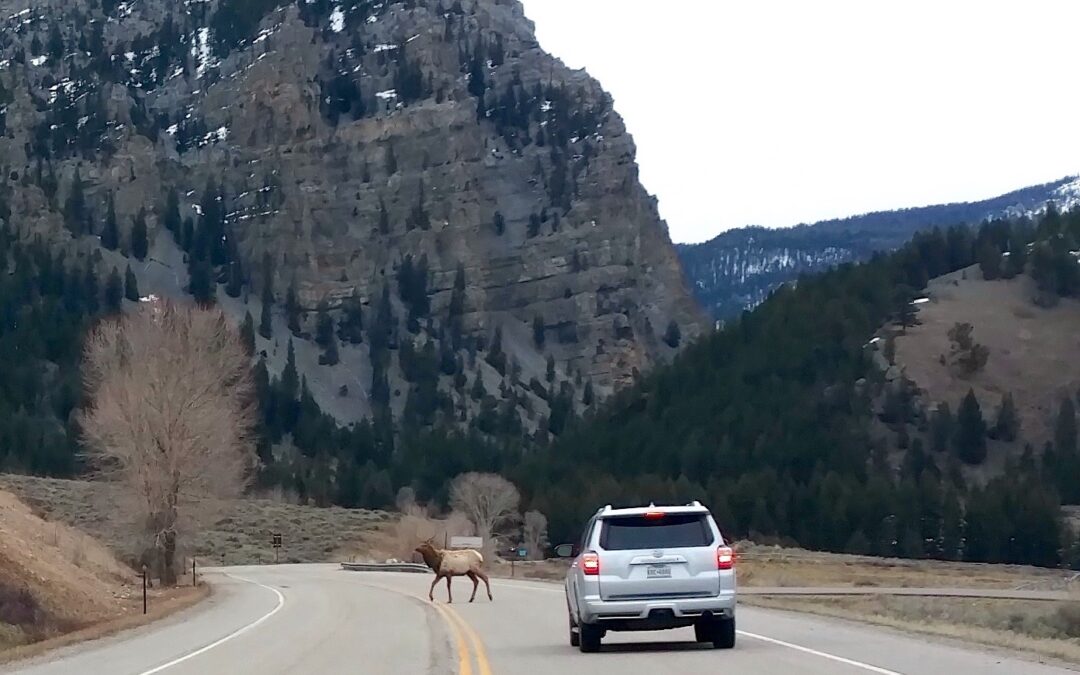
by jhwildlife | Nov 4, 2023 | Blog
By Renee Seidler
Sunday November 5th at 2 am is the end of Daylight Saving Time!
Why do we care?
The end of Daylight Saving Time, an age-old practice that is supposed to give us more waking daylight hours, is the number one worst day for wildlife-vehicle collisions in the US. That may seem odd, so let me explain. Animals (and plants!) are amazing creatures with the ability to adapt to changing environmental conditions (albeit there is almost always a time gap to achieve the greatest adjustment due to the ‘learning curve’). Animals move across the landscape to seek food and water and they move away from threats and hazards. They do this adaptively; for example, mule deer migrate in the spring following a ‘green wave’ of maturing plants as snows melt and temperatures warm, only to repeat the migration in reverse in the fall to find the most accessible winter forage such as on wind-swept or south-facing ridges.
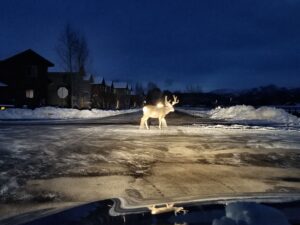
How can you avoid getting into a collision with an animal? Knowing this information is a good start!
These animals adjust their departure time and movements each year to find the best forage. Believe it or not, these animals know our commuting hours! When we are driving through that annoying rush-hour to get home, animals avoid crossing the road as best as they can, even when the resources they need are on the other side of the road. In fact, they are so good at avoiding high density traffic that if there is no relief from high traffic levels, animals will opt to never cross the road, i.e., it becomes a barrier. So, we have conditioned animals to our predictable movement patterns to protect their own lives by crossing roads when we are less likely to be driving the road.
Then along comes Daylight Saving and we are not predictable anymore. In the fall, the end of Daylight Saving means we are suddenly driving home on weekdays one hour earlier than usual. Compound that with animals attempting to avoid hunters (which further distracts animals), seek mates during the rut/breeding season (even more distraction), migrate to more favorable climes for the winter, navigate shorter days, and you have quite a perfect storm that can spell out more animals on the road at the ‘wrong time.’ This results in more wildlife-vehicle collisions in the fall, especially starting with the end of Daylight Saving.
How can you avoid getting into a collision with an animal? Knowing this information is a good start! It is proven that being more attentive (e.g., don’t use your phone), driving the speed limit (because it makes it harder to stop before you hit the animal in the road), expecting more critters to cross the road when you see just one, knowing where animals are more likely to cross the road such as at stream crossings or migration routes (look for the road signs!), and helping warn other drivers of hazards by using your flashers when animals are in the road.
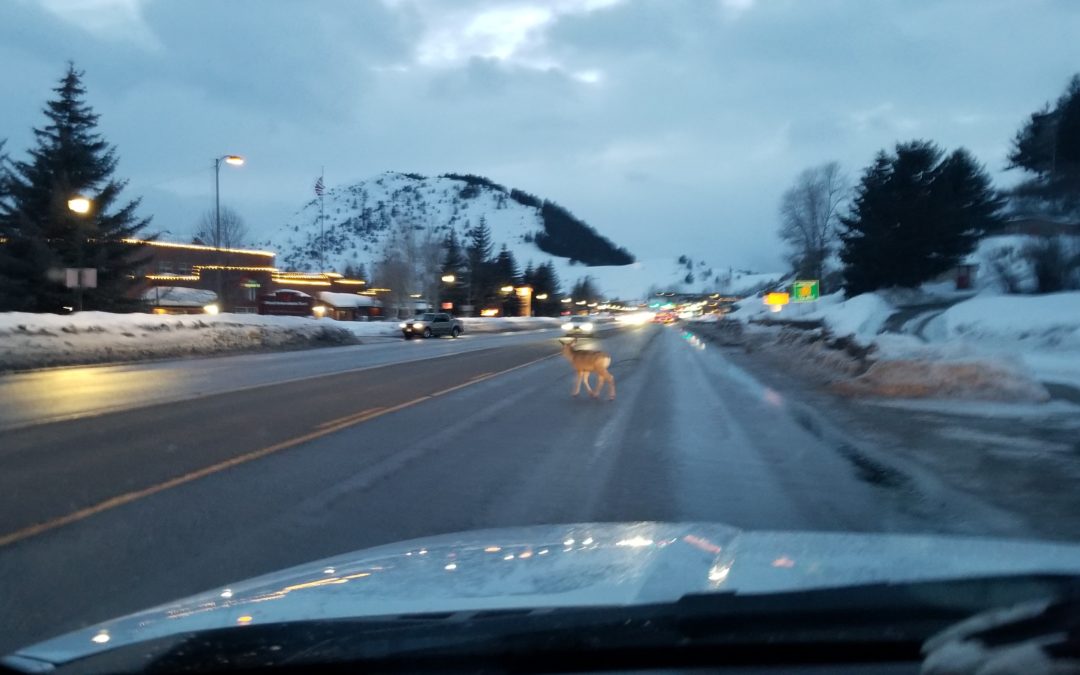
by jhwildlife | Jan 22, 2020 | Blog
By Kyle Kissock |
Do slower speeds reduce the chance of a wildlife-vehicle collision?
While the short answer is yes, the longer answer is likely a bit more complicated.
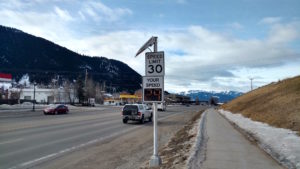
In winter, ungulates like mule deer cluster on the low-elevation buttes around town. Driving the posted speed can help reduce your chances of a collision with an animal.
An article in a recent Jackson Hole News and Guide highlighted the research of biologist Corinna Riginos, who was contracted by the Wyoming Department of Transportation to study the effects of reduced nighttime speed limits on wildlife-vehicle collision (WVC) rates on high-speed roadways.
Riginos’s results indicated that site-specific, nightly speed limit reductions from 70 mph to 55 mph failed to decrease WVCs.
The reason? Despite lower posted nightly speed limits (and in some cases increased enforcement) drivers decreased their average vehicle speeds only 3-5 mph.
This decrease in speed was likely not enough to compensate for the fact that vehicles traveling through “high-speed” study sites were moving relatively fast to begin with.
As the vast majority of WVCs occur at night, drivers involved in collisions likely still “outran” their headlights, a phenomenon that becomes increasingly hard to avoid (even for attentive drivers) as vehicle speeds exceed 35 mph.
However, it’s important to note that this study focused on a specific type of road; high-speed, two lane highways, and does not mean that slower speed limits are ineffective at preventing WVCs.
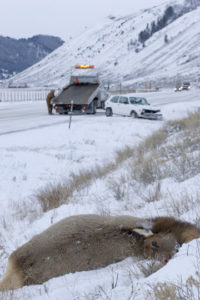
Rigino’s recent study showed that on high-speed roadways (70-80 mph) nighttime speed limit reductions had little effect to reduce wildlife-vehicle collisions
As Riginos points out, research indicates that deer-vehicle collisions in zones with permanent speed limits of 65 mph were over 60% more likely to occur than deer-vehicle collisions in zones with permanent speed limits of 55 mph. In these areas, even a 10 mph decrease made a significant difference.
What about nightly speed limits in Teton County?
Although it does get harder to avoid WVCs at night as you “outrun” your headlights, reducing your vehicle speed still means increased reaction time as a driver.
Currently, ungulates in our valley are residing at low elevations and spending time on or near roadways where travel is easier than wading through the deep winter snow pack.
It’s on these town and county roads, where speed limits are relatively low to begin with, that driver behavior can have an out sized impact on avoiding collisions with wildlife.
For example, reducing your speed from 40 mph 30 mph on Broadway (in the 30 mph posted stretch) likely has more of an impact on collision avoidance than if you were to reduce your speed from 80 mph to 70 mph on, say, Interstate-80.
Moose-Wilson Rd, N. Highway 89 in Grand Teton National Park, and south of town near Rafter J are examples of where recent WVCs have occurred, and where abiding by the speed limit at night (it is the law after all) can truly safe a life.
By modeling good driver behavior, those of us who care deeply about wildlife can set examples for the rest of our community to follow!





